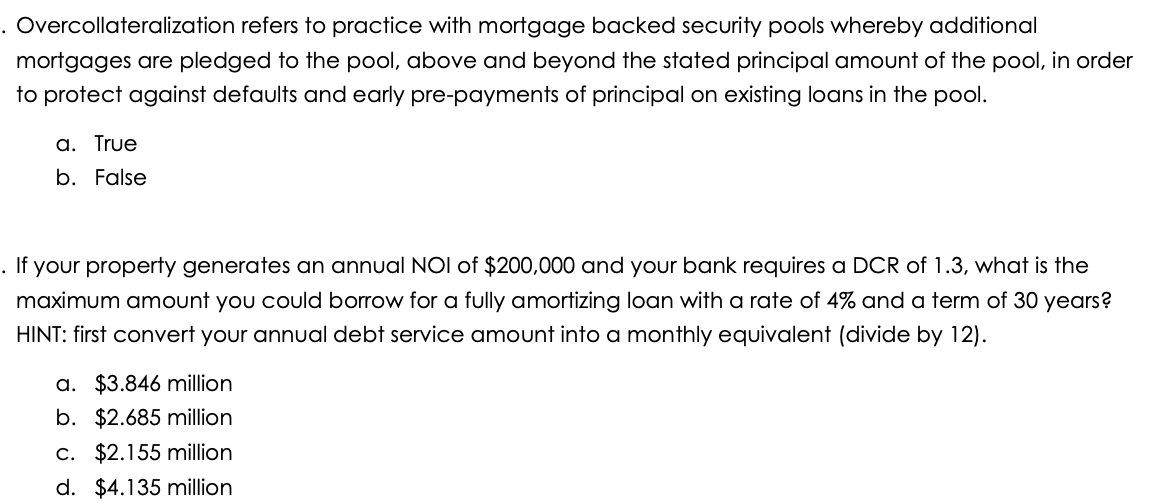Overcollateralization refers to practice with mortgage backed security pools whereby additional mortgages are pledged to the pool, above and beyond the stated principal amount of the pool, in order o protect against defaults and early pre-payments of principal on existing loans in the pool. a. True b. False f your property generates an annual NOI of $200,000 and your bank requires a DCR of 1.3, what is the maximum amount you could borrow for a fully amortizing loan with a rate of 4% and a term of 30 years? HINT: first convert your annual debt service amount into a monthly equivalent (divide by 12). a. $3.846 million b. $2.685 million c. $2.155 million $4. 135 million
Overcollateralization refers to practice with mortgage backed security pools whereby additional mortgages are pledged to the pool, above and beyond the stated principal amount of the pool, in order o protect against defaults and early pre-payments of principal on existing loans in the pool. a. True b. False f your property generates an annual NOI of $200,000 and your bank requires a DCR of 1.3, what is the maximum amount you could borrow for a fully amortizing loan with a rate of 4% and a term of 30 years? HINT: first convert your annual debt service amount into a monthly equivalent (divide by 12). a. $3.846 million b. $2.685 million c. $2.155 million $4. 135 million
Cornerstones of Financial Accounting
4th Edition
ISBN:9781337690881
Author:Jay Rich, Jeff Jones
Publisher:Jay Rich, Jeff Jones
Chapter8: Current And Contingent Liabilities
Section: Chapter Questions
Problem 81.3C
Related questions
Question
Finance

Transcribed Image Text:. Overcollateralization refers to practice with mortgage backed security pools whereby additional
mortgages are pledged to the pool, above and beyond the stated principal amount of the pool, in order
to protect against defaults and early pre-payments of principal on existing loans in the pool.
a. True
b. False
. If your property generates an annual NOI of $200,000 and your bank requires a DCR of 1.3, what is the
maximum amount you could borrow for a fully amortizing loan with a rate of 4% and a term of 30 years?
HINT: first convert your annual debt service amount into a monthly equivalent (divide by 12).
a. $3.846 million
b. $2.685 million
c. $2.155 million
d. $4.135 million
Expert Solution
This question has been solved!
Explore an expertly crafted, step-by-step solution for a thorough understanding of key concepts.
Step by step
Solved in 2 steps

Knowledge Booster
Learn more about
Need a deep-dive on the concept behind this application? Look no further. Learn more about this topic, finance and related others by exploring similar questions and additional content below.Recommended textbooks for you

Cornerstones of Financial Accounting
Accounting
ISBN:
9781337690881
Author:
Jay Rich, Jeff Jones
Publisher:
Cengage Learning

Cornerstones of Financial Accounting
Accounting
ISBN:
9781337690881
Author:
Jay Rich, Jeff Jones
Publisher:
Cengage Learning